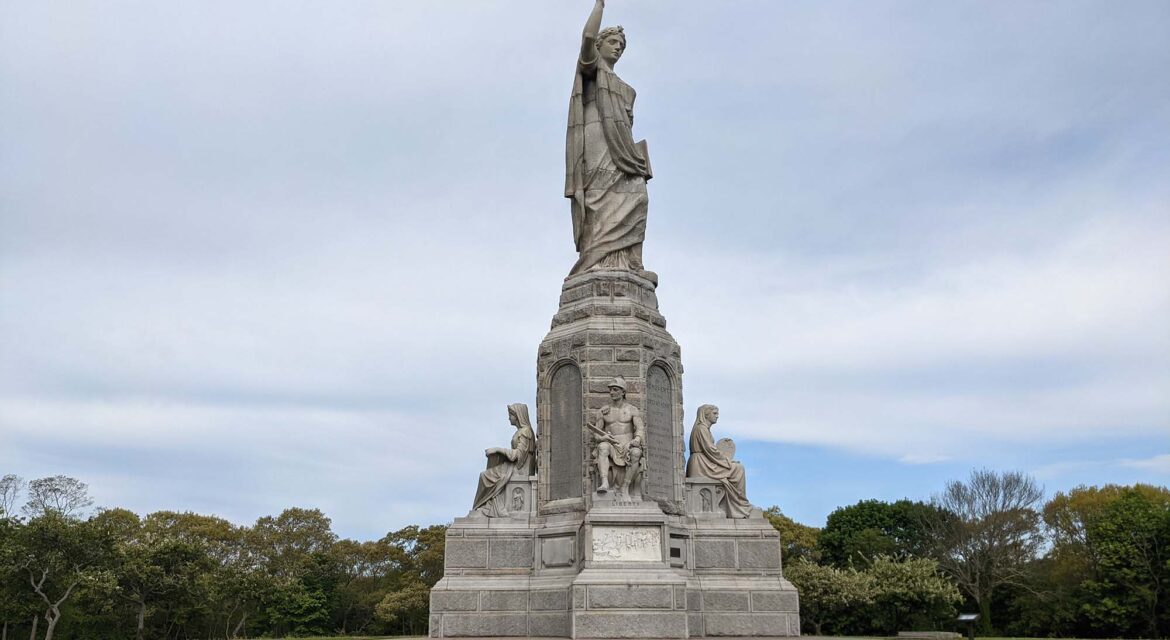 It’s no coincidence that the National Monument to the Forefathers is located within walking distance of Plymouth Rock in Plymouth, Massachusetts. While the monument is not literally connected to the icon in the way that was originally envisioned, it has been able to augment the legacy of the region while also becoming a notable attraction that pulls in audiences from across the world due to the incredible scale and scope of the landmark.
It’s no coincidence that the National Monument to the Forefathers is located within walking distance of Plymouth Rock in Plymouth, Massachusetts. While the monument is not literally connected to the icon in the way that was originally envisioned, it has been able to augment the legacy of the region while also becoming a notable attraction that pulls in audiences from across the world due to the incredible scale and scope of the landmark.
A Colossal Monument
 The idea for what would become the National Monument to the Forefathers stretches back to the bicentennial commemoration of the Pilgrims’ arrival in Plymouth. In the 1820s, the Pilgrim Society planned the creation of a colossal monument that would be dedicated to the people who arrived from England in 1620. At the time, they were known at the time as the forefathers, which is why the monument was both named for them and depicted their virtues in allegorical form. These virtues were also reflective of 19th century American ideals, connecting the monument to multiple eras of America.
The idea for what would become the National Monument to the Forefathers stretches back to the bicentennial commemoration of the Pilgrims’ arrival in Plymouth. In the 1820s, the Pilgrim Society planned the creation of a colossal monument that would be dedicated to the people who arrived from England in 1620. At the time, they were known at the time as the forefathers, which is why the monument was both named for them and depicted their virtues in allegorical form. These virtues were also reflective of 19th century American ideals, connecting the monument to multiple eras of America.
A 150-foot tall monument was designed to stand astride of Plymouth Rock and tower over Plymouth Harbor. It became evident that the waterfront could not support a monument of this size though, which compelled a shift of the location and scope of the project. By the time the National Monument to the Forefathers was completed in 1889, the monument had been reduced to being 81-feet in height and was placed several blocks northeast of Plymouth Rock.
Despite the reduction in size and change in location, the piece was one of the largest solid granite monuments in the world, enabling it to resonate with different types of audiences for a variety of reasons.

Connecting Audiences Across the Eras
 Each of the 13 allegorical figures on the monument was carved from a single block of granite and are inscribed with a name of what they represent. Capped by a 36-foot tall statue of “Faith,” the other main statues represent morality, law, education and liberty. Smaller allegorical figures represent other virtues, each of which is flanked by a marble relief that depicts a scene from Pilgrim history. Between each buttress resides an information tablet. These pieces detail the monument’s dedication as well as a list of the Mayflower Pilgrims and quotes that are connected to the history of Plymouth Colony.
Each of the 13 allegorical figures on the monument was carved from a single block of granite and are inscribed with a name of what they represent. Capped by a 36-foot tall statue of “Faith,” the other main statues represent morality, law, education and liberty. Smaller allegorical figures represent other virtues, each of which is flanked by a marble relief that depicts a scene from Pilgrim history. Between each buttress resides an information tablet. These pieces detail the monument’s dedication as well as a list of the Mayflower Pilgrims and quotes that are connected to the history of Plymouth Colony.
All of these details have enabled it to become an attraction that is called out in maps and guides of the city. Mentioned as one of Plymouth’s “hidden gems” and a key feature on tours as well as an essential feature of Pilgrim Memorial State Park, the National Monument to the Forefathers has been able to create a positive indirect economic impact for individuals and the whole region.
Visitors are encouraged to bring a picnic to enjoy on the monument’s massive lawn, with community events and gatherings taking place in the space throughout the year. These types of activities resonate in different ways for both residents and visitors.
The effort to memorialize a Victorian-era interpretation of the Pilgrim’s has provided modern audiences with a monument that is connected to the history of the area in multiple ways. This connection will continue to evolve and attract the attention of audiences to positively impact the entire region.

Creating a Physical and Cultural Impact
 The National Monument to the Forefathers was first listed on the National Register of Historic Places in 1974 and was once visible for miles overlooking Plymouth Harbor. Additionally, the neighborhood where it resides has been shaped by the presence of the monument in a positive way.
The National Monument to the Forefathers was first listed on the National Register of Historic Places in 1974 and was once visible for miles overlooking Plymouth Harbor. Additionally, the neighborhood where it resides has been shaped by the presence of the monument in a positive way.
These reasons as well as it being recognized as the largest solid granite sculpture in the United States highlight just a few of the elements that showcase the physical and cultural impact the monument has enabled. All of them are connected to the legacy that it represents and will further define over the eras.


